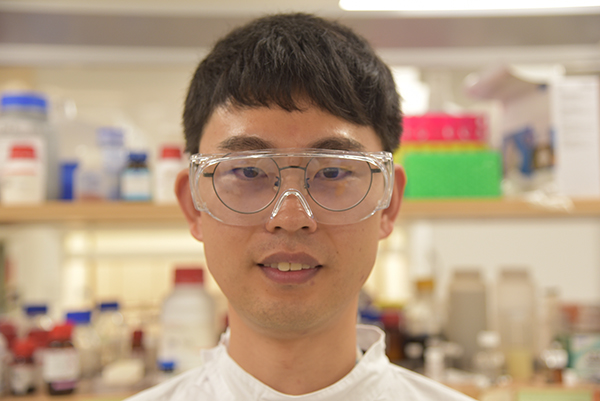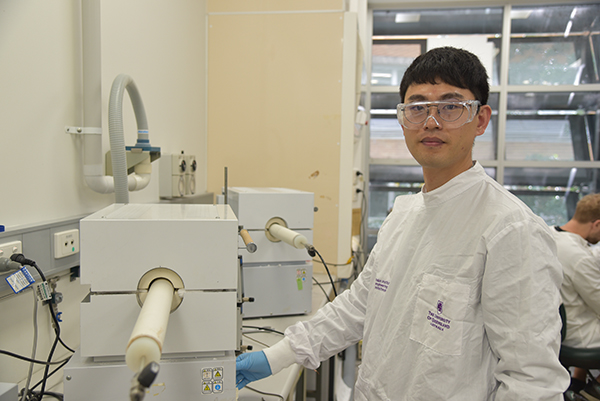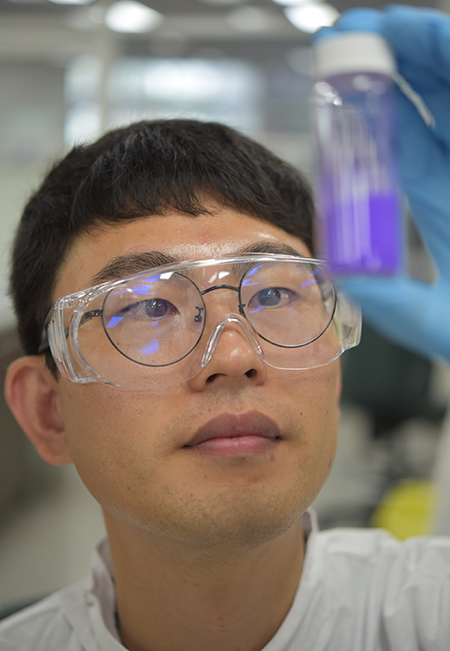
As a nanoarchitect, PhD student Minjun Kim is used to working small. But like many of his peers at the Australian Institute for Bioengineering and Nanotechnology, the scope of his research is massive.
Minjun has been using science that could fit on the head of a pin to create a “synthetic carbon” for smarter, better-performing batteries for mobile phones and other smart-tech devices.
This new carbon material is hollow, porous, shaped like a honeycomb, and can serve as a replacement for traditional carbon due to its sophisticated structure.
Minjun’s discovery has been published in prestigious journal Nature Protocols, despite him still being months away from completing his thesis, with the work already available to other research groups to adapt for their own applications.
Minjun says his research in the Yamauchi Group is tied to his deep concern for the environment and, ultimately, has been informed by the kind of world he wants to leave behind for his two young children.
“I would say as I grow older, and then as I see my children, I think more about the future I want to help create,” he says.
“Especially this year, I see so many natural disasters and a weird shift in the climate all around the world.
“And we know that that's because carbon emissions. So we need to act and become a more sustainable society.”
Read on to find out more about Minjun Kim, the incredible work he is doing, and how he hopes to save the planet.
-
Minjun you haven’t even finished your PhD and we’re already seeing your work published in internationally recognised journals. What exactly does your research involve?
At the most basic level I’m working with porous materials - any material that has pores or openings. I specifically work with porous carbon.
Porous carbon?
Yes that’s it. The good thing about carbon is it has unique properties, such as great stability and structural integrity, it can be applied to almost any applications that we use in today's world. It’s also electrically conductive, which makes it usable in energy related applications such as batteries and super capacitors. And when we make carbon porous – which is ‘activating’ the carbon – we’re opening up a whole new range of applications.
Porous carbon effectively has a greater surface area and can accommodate a greater content of reactants and adsorbents to influence the performance of various applications.

The problem of it is, the porous network is sometimes blocked or closed. So not all of the surface area gets used in our desired applications. That's the challenge we want to overcome.
What sort of applications are we talking about?
Myself, I work specifically on energy storage and energy conversion applications. Carbon materials can be used for things like lithium ion batteries. And it can be also used as electric materials for super capacitors.
I’m looking at carbon materials as the electric catalyst for fuel cells, which uses hydrogen to extract electricity to power something.
What has drawn you to this area of nano-research?
I believe our energy use is the most urgent thing we need to fix. But it is very tough. As the population grows the demand for electrical energy is only growing, but because most of our energy is still coming from fossil fuels, we will keep seeing a rise in major global disasters if we don’t change. Climate change has made it clear that we can’t keep producing energy the way we have been.
But then, even if we can generate a good amount of electricity from renewable energy sources, if we can't efficiently store that energy, or convert it to some other form for the later use, we’re only addressing 50 per cent of the problem. So that's what I want to help fix.
Level with us: we’ve got a lot of work to do, don’t we?
Yes, we're still very far away - at least in my opinion - from the truly sustainable society that we are aiming for. I think renewable energy consumption in 2021 was only 6.71 per cent of total energy consumption. And fossil fuel-derived energy counted for around 82 per cent. That huge difference means that we have a lot to do in terms of research around batteries and such.
We also need to do more around hydrogen. Hydrogen doesn’t cause carbon atoms. We split water to produce hydrogen. That's one technology we still have to achieve: low cost hydrogen energy. Research in this area is still lagging battery technology.
Are you hopeful that we can achieve better storage and conversion? That we can accelerate the work being done in this area?
I think it's difficult but it's possible. There is a significant amount of research that's published in the area of hydrogen-based energy sources.
The trick is going to be how we commercialise it.

Take for example the type of application that I'm working on, an oxygen reduction reaction catalyst, which is used in fuel cells.
The best electrochemistry lever catalyst we use at the moment is platinum which is, as everybody knows, very expensive. It’s not abundant.
So if we can only make use of hydrogen, by using platinum, even if it works, it's not going to a be good option to be a widely used or commercialised.
That's why I’m working with carbon materials: to replace platinum based catalysts with carbon based catalysts. And then, by creating carbon with cheaper metals, such as iron and cobalt, or even with metal-free we can achieve the catalytic performance comparable to platinum or even better than platinum.
Then we can talk about using cheaper catalysts to make use of hydrogen in fuel cells.
Would you say cost is the biggest barrier for industry and business when it comes to transitioning their energy supply and storage?
Yes I think so.
It’s not just the individual batteries that cost money, it’s all the infrastructure needed to make it work.
That's why the cost of new technology is always expensive, because it takes a little bit to integrate.
That said, if we keep working on this research and how we can make use of hydrogen, generate hydrogen, store hydrogen… I am sure the cost of production and cost of storage and cost of fuel cells will eventually decrease.
And if that works, then we might really see some better outcomes with emissions, with energy use, and with the environment.
Read more about the Yamauchi Group and its battery work here, and the JST-ERATO Yamauchi Materials Space-Tectonics Project here.
You can also meet more of our incredible researchers here.



